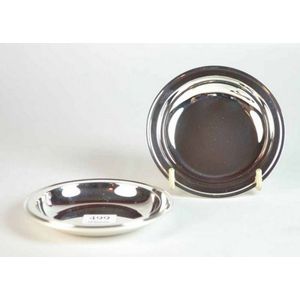19th Century Sterling Silver Soup Plate Set with Armorial Crests
You must be a subscriber, and be logged in to view price and dealer details.
Subscribe Now to view actual auction price for this item
When you subscribe, you have the option of setting the currency in which to display prices to $Au, $US, $NZ or Stg.
- Gadrooning - A series of lobes usually as a border. In furniture gadrooning is found as carved decoration around the edges of table tops in the Chippendale and Jacobean style furniture. Gadrooning is also found as decoration on the rims of silver and ceramics.
- Circa - A Latin term meaning 'about', often used in the antique trade to give an approximate date for the piece, usually considered to be five years on either side of the circa year. Thus, circa 1900 means the piece was made about 1900, probably between 1895 and 1905. The expression is sometimes abbreviated to c.1900.
- Armorial / Armourial - Bearing a coat of arms. Coats of arms came into general use by feudal lords and knights in in the 12th century, and by the 13th century, arms had spread beyond their initial battlefield use to become a flag or emblem for families in the higher social classes of Europe. They were inherited from one generation to the next. When a family crest is used on individual items of silver or furniture it is an indicator of the aristocratic standing of the family represented.
Armorials were also used to decorate mass produced ceramic souvenir ware by such companies as Goss, Carlton & Shelley, and in these cases the coats of arms displayed were of boroughs and cities. - Engraving - The method of decorating or creating inscriptions on silver and other metal objects by marking the surface with a sharp instrument such as a diamond point or rotating cutting wheel.
- Sterling Silver - Sterling silver is a mixture of 92.5% pure silver and 7.5% of another metal, usually copper. Fine silver is 99.9% pure silver, and is relatively soft and the addition of the very small amount of copper gives the metal enough strength and hardness to be worked into jewellery, decorative and household objects.
This item has been included into following indexes:
Visually similar items

A pair of cufflinks by Georg Jensen, designed by Flemming Eskildsen, with horse shoe motif styled in sterling silver, reference 123

Three 800 silver graduated circular trays together with a matching oval serving dish, each with a gadrooned border. 1587gm total. 821gm oval tray.

Five Wedgewood porcelain plates, circa 1938, by Keith Murray, stamped Wedgwood Made in England, Keith Murray, 21 cm diameter

A pair of Georg Jensen Harald Nielsen sterling silver Pyramid, butter bowls, 600A, one stamped with Georg Jensen GJ monogram, the other with dotted circle mark, diameter 8.9 cm, total weight 98gms
